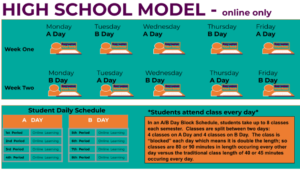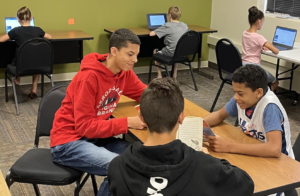Online Charters Expand Learning Options

This blog originally ran on EducationNext.
With the rise of options for anywhere, anytime digital learning, statewide schools play an important role in providing equitable access to a variety of quality learning pathways.
It no longer makes sense to limit a family’s learning options to services only provided by a local school. It would be the entertainment equivalent of only allowing access to local TV and radio stations, or the retail equivalent of blocking Amazon and only allowing access to local retailers. Or when it comes to employment, only allowing people to work for local companies. None of these examples make any sense in the information economy.
Online learning—both full and part-time—serves many different kinds of students in many different circumstances. Some learners are way ahead and seeking challenges not found at their local school. Some are way behind and have not been well served by their neighborhood school. Some move with their families on a regular basis. Some were bullied at school. Some are homebound. Some have experienced difficult family circumstances. Some want to explore an interest in an elective course or build fluency in a world language not offered at their school. And some are athletes who need the flexibility to train (like speed skater Apolo Ohno, who graduated from the online school launched by the district where I was superintendent in 1995).
Most online schools are operated by school districts. Most of these schools serve in-district students, but some serve students regionally across a consortium of districts. In many states, district-operated online schools serve students statewide (See Figure 1). As with magnet programs and special programs, districts can create enrollment criteria and exercise enrollment discretion. There would be more of these schools with larger enrollments if all states had open enrollment where adequate funding followed students to cover the costs to educate them.

The Role of Online Charter Schools
It now is possible, affordable and desirable to provide every family with quality options in terms of place, pace and course of study. Every student should have access to the top world languages, advanced courses and dual-enrollment opportunities, specialized electives and career and technical education linked to work experiences. Students with special health needs should be able to learn at home. Students who move with their families should be able to learn on the road.
Online (or virtual) charter schools are typically nonprofit organizations authorized to serve students anywhere in a given state. In the 24 states where online charter schools exist, some are locally operated by nonprofits using commercial platforms and content, some nonprofits contract with local partners for content and instructional services and other nonprofits contract with national partners. There are, with a few exceptions like in Arizona, no for-profit charter schools.
Like traditional schools, online charter schools take all comers even if they enroll late and are way behind. More than half of families—or 61% according to one national provider—are fleeing a situation that wasn’t working for their child’s academic, social or health needs. Some families need to move and are looking for one stable link.
Because so many of the students who enroll in online schools show up late and are behind in their studies, it’s not surprising that many don’t achieve grade-level proficiency at the end of the year. However, many make good academic strides during the year, and that’s not well captured by current measures—or by recent studies.
In fact, one recent piece of research—a 2015 report from the Center for Research on Education Outcomes (CREDO) at Stanford University—suggests that students in online charter schools aren’t doing as well as their peers. I’ll show here that the CREDO report is problematic in three areas: measurement, policy and learning environments.
The Need for Better Measurement
Since No Child Left Behind (NCLB), states have relied primarily on end-of-year tests to measure grade-level proficiency. These testing and accountability systems don’t provide accurate measures of individual academic growth. As outlined in the iNACOL Quality Assurance Performance Metrics, states, authorizers and researchers should adopt more accurate measures of individual growth, such as the pre- and post-assessment measures typically used by national online learning support organizations (for example, the Measures of Academic Progress [MAP] or the equivalent). These data often provide a better measure of academic gain than do state test results, and they accurately reflect the period of time the student was in school.
Most online schools have higher-than-average rates of student mobility—a fact that states are beginning to consider in their accountability frameworks. For example, Ohio adjusts value-added calculations for high mobility, and Arizona calculates the percentage of students enrolled for a full academic year and weighs measures of test score levels and growth differently based on student mobility and length of enrollment.
Or look at Niobrara County’s Wyoming Virtual Academy, which receives a high number of high school transfer students who are behind in credits and not on track to graduate. This skews the receiving school’s and district’s graduation rate and overall accountability rating. As Niobrara County Superintendent Aaron Carr said, “That factor plays into making us look like a failing school when we’re not.” Carr says he has a moral responsibility to students who need to attend the academy, no matter what it means for his district’s performance data.
The impetus for this debate is the aforementioned CREDO study, which my forum partner, Greg Richmond, touts as proof that online charter schools don’t work. CREDO used a “virtual twin” approach to attempt to measure the effectiveness of online charters by comparing the test score growth of students learning online to that of matched students in traditional schools.
There are at least two problems with this approach. First, the family of the online student left the traditional school for a reason—it could be because of bullying, health issues, a military move or a change in employment. In all cases, the student moving was subjected to a stressful life change that required a flexible learning environment.
A second problem with the study is mobility itself. The study includes a high percentage of students in their first year in an online school. It’s not surprising that students in a new setting and instructional model might show less academic growth than those who stayed put. Students in any setting tend to perform better the longer they’re enrolled.
Critics who call for closing online schools on the basis of the three- to six-year-old data that CREDO used should ask three questions:
- Are the data reflective of students’ current academic progress?
- Are we adequately measuring growth, or do our measures primarily reflect a group of students underserved by traditional schools who enrolled late in a school of last resort and struggled on a proficiency exam?
- If the majority of the 275,000 students enrolled in online charter schools are fleeing a bad situation, where would they go if their schools were closed?
The Need for Better Policy
Full-time online learning is great for some families. In some cases, it’s the last and only resort. But it’s not for everyone. It requires engagement and commitment from the student and supervision from a parent or an advisor.
For well-intentioned reasons, online and physical charter schools in most states are required to take all students who apply. This prevents creaming top-performing students. But it also prevents schools and families from fully investigating fit before enrollment. District online schools don’t have this problem; they can fully investigate the student’s academic status, learning goals and support needs, and make an appropriate placement.
Giving statewide online charter schools the ability to accept or reject students isn’t the solution, but four policies would improve the student-school match:
- Monitor student growth. Arizona law requires school policies to monitor student growth during the school year relative to student-specific benchmarks, whether the student attends a traditional or an online school. Both student and school are held accountable for student success. Ohio and North Carolina require schools to ask parents to estimate the length of time they believe the student will be enrolled in the online school to help determine the best fit for the student and to clarify the student’s reason for wishing to attend.
- Clarify policies in writing. Student handbook policies should set clear expectations for students on the level of participation required and the types of supports available.
- Require an orientation session. Ohio requires that prospective students and their parents or advisors visit the school (either on site or by video conference) to learn about expectations, conditions, schedules and supports. The goal isn’t to screen students, but rather to help families make a more informed choice. Orientations, training, and onboarding all help schools better understand and serve families and don’t infringe on parent choice or student access.
- Offer students and families the services of an advisor. An advisor, who may be a school counselor or paraprofessional, like those provided by the Louisiana Supplemental Course Academy, can advise students on courses available, how those courses would apply toward graduation requirements, and what may (or may not) be an appropriate placement. Starting with an advisor—what Donnell Kay’s ReSchool Colorado program calls a learner advocate—is an effort to rethink education in the digital era.
The fact is, we need to ensure quality options for all families—and this should include incentives to serve struggling students. With better measures of academic growth and a little extra money, states could attract providers to underserved populations, rather than discouraging them as a result of the requirements of current accountability systems.
For online schools, better measures would include examining the performance of new and returning students, as well as that of on-time and late-enrolled students; defining full-academic year students; and looking at longitudinal student performance, such as progress toward graduation in four, five and six years. Modernizing state accountability systems is not only good policy for district or multi-district online schools, but all of public education would greatly benefit from the next generation of school accountability frameworks.
A performance-oriented funding system would also help address identified problems, for online as well as traditional schools. I’ve advocated elsewhere for weighted, flexible, portable and performance-based funding, where a portion of state aid could be tied to completion and achievement.
The Need for Better Learning
The CREDO report relied on data from 2012 and earlier. Since then, the nation’s largest online school provider, K12, has published several academic reports and white papers that detail promising school-by-school outcomes. Recent data—as opposed to the older data that CREDO relied on—reflect some of the many improvements that online schools are currently making. For example, K12 is in the middle of a full curriculum and platform update, with more engaging coursework linked to higher standards. And both K12 and Connections schools use adaptive pre- and post-assessments that provide a more accurate picture of individual student progress than the virtual twin method used by CREDO.
The Glass Half Full
Even with improvement, better measures and better policies, big online schools will likely have performance levels similar to those of big districts serving high-need, high-mobility populations. Key will be the ability to disaggregate performance data by the type of students served and by their time enrolled.
And even with current policy and measurement limitations, the CREDO study suggests that thousands of students in virtual charter schools were doing as well or better than their peers. For struggling and harassed students, online schools may be their last resort. For both accelerated and struggling students, it’s worth building on success, improving our ability to track the progress of individual students and providing better information to families about educational options.
For more, see:
- Examining Policy Recommendations for Online Charter Schools
- Smart Lists: 70+ Top Charter Networks & School Managers
Stay in-the-know with all things EdTech and innovations in learning by signing up to receive the weekly Smart Update. This post includes mentions of a Getting Smart partner. For a full list of partners, affiliate organizations and all other disclosures, please see our Partner page.








0 Comments
Leave a Comment
Your email address will not be published. All fields are required.